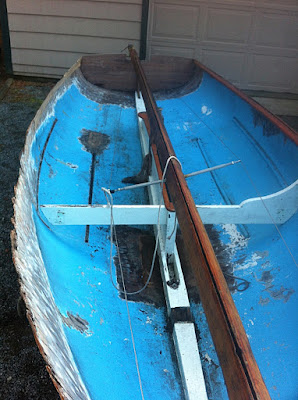From Pat's email:
"Here are a couple of photographs of US 269 which a friend and I built in high school from a Douglass and McLeod kit in 1947 in Erie, PA . The kit came with the centerboard case installed, so the difficult carpentry was done. We did all the rest . It was quite a surprise to the local small boat sailors to see the impressive performance of this boat. We sold the boat in 1952 and I don't know its fate.
By the way, the picture on Mar 2 of the interior is not a Douglass and McLeod model which was very similar to the Thistle, with a number of lateral slats forward near the mast step, and a number of lateral slats aft near the transom. There were two flotation tanks, one forward of the mast and the other just forward of the transom.
US312 was also in Erie PA in 1948 but we were never able to get a larger class going. We did race the boat at Put-in-Bay, OH a number of times."
Interesting about Pat's comments on the standard interior layout of the Douglass and McLeod One-Design. I do know that finishing off the shells, as Pat and his friend did, was a common way to get into the International 14 class in the 1940's and 1950's, and with all the amateur completions, there may be a wide variety of interiors. The interior layout I featured in a previous post as being of a One-Design was typical of the Uffa 14's being built in the late 1930's and was carried over to the early Fairey Marine 14's in the late 1940's. Come to think of it, the photo in that previous post may be a early Fairey Marine 14 and not a US One-Design. Oops! (After some thought, I've corrected that previous post.)
The two pictures, Pat sent along:









